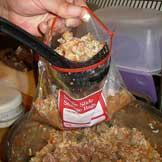
A couple of weeks back, TheOldBroad ask about the appropriateness of feeding critical care diets to cats on a long-term basis. “It’s very palatable and the critters seem to really like it,” TheOldBroad said. “However, it’s my understanding that it’s not a good option for a long-term diet.”
TheOldBroad is right. Cats do really like these critical care/recovery type diets. They have been designed to be very appealing so that patients with poor appetites find them hard to resist. They are also highly digestible and calorie and nutrient dense, so even if a cat eats a relatively small amount, he or she receives a big nutritional boost.
For me, answering the question of whether or not these products are appropriate for long-term feeding depends on one’s definition of “long-term.” If we are talking about a cat who has been diagnosed with a terminal disease, has a life-expectancy in the range of weeks to a month or two, and is uninterested in other foods, I say “yes.” I do not believe that any nutritional deficiencies that might develop over such a relatively short period of time would be significant enough to adversely affect the cat’s outcome. And let’s be honest, when we’re dealing with end of life care, we’re often more concerned with quality rather than quantity of life. Do we want to put these cats through the stress of an unwanted change in diet or spoil them rotten and give them anything that they want?
Cats who have become addicted to these foods as they are recovering from illness are a different story, however. If you look closely, you’ll see that these products are labeled for both dogs and cats. Even though some say they meet the AAFCO (Association of American Feed Control Officials) Cat Food and Dog Food Nutrient Profiles for Maintenance (others do not make this claim), it is impossible for one formulation to provide optimal nutrition to both dogs and cats.
Here’s a comparison of one manufacturer’s critical care food and one of their adult maintenance, canned diets for dogs and cats:
You can see that they are quite different in many regards.
When a cat has developed a strong preference for a particular food, making a dietary change is an exercise in patience. Go v-e-r-y slowly.
Find a life-stage appropriate canned food that has a similar list of ingredients to the critical care/recovery diet. If you can find one that has a smooth consistency similar to the recovery foods, go with that one. If not, put flaked or chunked foods in the blender (adding a little water if necessary) before mixing the old and new together. Gradually increase the amount of new food you are mixing with the old. It may take weeks until your cat is eating only the new food and a few more before you can put the blender away, but getting him or her back on an optimal diet is worth the effort.

Dr. Jennifer Coates
Image: Thinkstock









